Category: My Blog
Ballerina Ingrid Silva on Unraveling Stereotypes: ‘I Can Still Look Classical and Elegant With My Natural Hair’
This interview is part of Health’s #RealLifeStrong series, where we are celebrating women who represent strength, resilience, and grace.
Ingrid Silva is turning the stereotype of a ballerina body on its head. Here, the 29-year-old—who’s currently in her sixth season at the Dance Theatre of Harlem in New York City—opens up about being the only black girl in her ballet class, forging her own career path, and why representation matters.
Did you always know you’d become a ballerina?
Growing up in Brazil, I wanted to be a swimmer so badly. I started ballet relatively late, when I was 8 years old, and I never saw myself dancing [long-term]. When I was 11, I went to one of the biggest dance schools in Brazil, and I met a teacher who sparked more of a love of dance in me. The challenges—and how every day I accomplished something different—were magnetizing for me. Ballet was taking up so much of my life, I decided to just invest in it.
At 17, you left Rio de Janeiro to study at the Dance Theatre of Harlem. What inspired you to go to New York?
I knew it was a great opportunity, but my mom was with me every step of the way, guiding me through it. I didn’t want to go. When you’re young and you get these opportunities, it’s hard to think as far ahead as the people around you. I did see a future for myself in dance. But I didn’t imagine it would get to where it is now. I would never dream of that.
What was it like to move so far from home?
When I first got here, I learned English, I learned the culture. I had to fight even more for the things that I wanted, especially being an international dancer. Just finding my space in myself and in the company, and growing as a woman and as a person, it was such a challenge. I could barely communicate, so I was lonely. I was sad. I wanted to go back for the first few days. But I always had my family’s support.
You’ve carved your own path in an industry known for its extremely strict standards—how did you do it?
People see ballerinas as a typical white, skinny, tall girl. It’s so much more than that. When I arrived at Dance Theatre of Harlem I felt very welcome. I felt like I found people who looked like me. I felt like I was where I belonged. In Brazil, there wasn’t much diversity. I was the only black ballerina in my class! And when I came to America, in this company, I was just one more.
Did that make you feel empowered to be yourself?
There are certain standards to dance that you have to follow—ballet is very specific, and you have to look formal, and you have to look a certain way. I think for me, it was more finding a way to look classical and elegant as a ballet dancer, but also look like me. I can still look classical and elegant with my natural hair. I can be classical and elegant with my own body. That was empowering.
Do you feel a responsibility to help other young dancers reach the same conclusion?
I mentor through an organization called Brown Girls Do Ballet. In my generation, I didn’t have anyone I could relate to and look up to. These girls can see me dance, or online, or in a magazine, and they see that it’s possible. And that’s where I think that representation matters. It’s not even about your body type, or your skin color. It’s about finding someone who inspires you. That’s my goal—to connect with people and help change their lives, even if it’s just through a conversation.
How do you deal with career hurdles these days?
I feel like the ballet career is going to be hard forever. You always want to be a better “you” every day. And you want to be perfect, which doesn’t exist. But one thing is important: to be consistent. And right now, I’m trying to be consistent more and more. That’s different than being perfect, because we’ll never be perfect.
What is your advice to for handling setbacks, and moments of self-doubt?
I remember that just because something doesn’t work one day, doesn’t mean it won’t work the next. And yes, you’re going to get frustrated, but personally, I started learning how to deal with my emotions. When I was young, when things wouldn’t go right in ballet, I would go home and cry. My dad once asked, “Why do you always get so upset? If it makes you so sad, why don’t you quit?” And the answer was that I could never see myself doing anything else. Growing up now, even when I get frustrated, I understand: Hey, it didn’t work today. You can do better tomorrow.
We want to hear about more #RealLifeStrong women. Nominate yourself—or a friend or family member—here. We’ll be sharing the most inspiring stories we receive in the months ahead.

The 15 Best Butt Workouts from Kelsey Wells, Jeanette Jenkins and More Fitness Stars
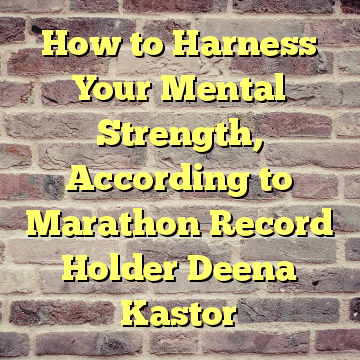
How to Harness Your Mental Strength, According to Marathon Record Holder Deena Kastor
When it comes to running, or any fitness feat for that matter, it’s not just about how well your body performs; it’s also about your mental strength. And that is exactly what Olympic bronze medalist and long-distance runner Deena Kastor, 45, talks about in her new memoir, Let Your Mind Run ($27; amazon.com), on bookshelves today.
“Our choices, thoughts, and perspectives are the drivers of our physical ability,” explains Kastor, who is racing the Boston Marathon next week. “A pessimist might have the ability to reach their goals, but decades of positive psychology would support that optimism makes reaching your goals easier—and may also give you the ability to reach beyond what you’ve ever expected out of yourself.” Here, Kastor shares some of the mindfulness techniques she’s learned over the miles.
On training holistically
“There are so many training programs out there that talk about mile repeats, tempo runs, long runs. I thought that my greatest asset was my mind, and learning how to cultivate it. All the talent in the world isn’t going to get you anywhere because we need to pay equal attention to our minds and our bodies. So many of us obsess about training plans and what is going to get us to that finish line, and I will tell you now that the physical training is not going to reach your potential if you are not cultivating a strong mind to get there.”
On tuning into your thoughts
“We produce over 50,000 thoughts a day that shape our perspective, our voice, and our actions. I take advantage of all of these thoughts to ensure they are leading me in the direction I want to go. First, I pay attention by listening to my mind’s reaction, and then, I analyze how I might shape the thought to strengthen me.”
On the power of gratitude
“Instead of dreading a difficult task such as training or deadlines, I think of how grateful I am for the opportunity to extend my limits or share my perspective.”
RELATED: Why Running Is My Favorite Way to Commute to Work
On being accountable
“Sometimes when I’m challenged, I can easily justify compromising. But it’s not just about the immediate goal, and more about creating mental habits of persistence, resilience and commitment. In training, every time I choose courage over fear, or persistence in the wake of challenge, I know I am building myself more capable to handle challenges in life.”
On always learning
“What I learned throughout the years of trying to twist my thoughts and be better, stronger, more grateful—all these attributes of positivity that have helped fuel me is that that the process is never-ending. Even on a flight delay coming out to Washington earlier this week, my first thought was, ‘Damn it!’ But then I was like, ‘Oh, now I can try that café I passed.’ And so it’s just always twisting that, and running has taught me that. But, it is certainly most valuable in life.”
On embracing struggle
“That struggle in the marathon is my favorite part of the race. When it gets there, my first thought is ‘Oh no,’ and then I remember this is where I get to do my best work. This is where I get to shine and get better, be better than the person I am in this moment. I get to push my physical boundaries, my mental limits; and I really have fun in those moments. And sometimes it just takes telling yourself that you can get to the next mile, and when the next mile seems unbearable, it’s the next light post, and when that doesn’t seem possible, you say ‘OK how about one step at a type.’ And when that seems excruciating, you think ‘let’s look at the signs everyone is holding on the sidelines and completely distract yourself.’ So it is just working through all of those tools to try and get to that place that gets you to the finish line. And sometimes you have that epiphany and feel amazing and sometimes you just keep working until you get to the finish line—and you get the to end result that you are working toward nonetheless.”
RELATED: 4 Ways to Stay Safe When You’re Running Alone
On finding the positive in negative
“I remember thinking about how disappointed I was after a race—and long ago, I used to own that disappointment, and disappointment meant I was a failure. And it took some twists and turns, and now disappointment means to me that I really care, and I know I have better in me, and let’s get to better and how do we do that. So it’s just showing that some of these negative terms in our lives could actually be rooted in positive meaning that can be springboards for you. A lot of it has to do with having a growth mindset versus a fixed mindset. Like disappointment means this is as good as I am and I am a failure, whereas disappointment can mean you want to do better, this is where I am, how can I go after it and get better from this moment. What you did wrong, what you did right, and then move on from it.”
On owning your power
“Our minds are shapeable, trainable, and deserve the same, if not more attention than our physical bodies.”
On sharing your gifts
“In the dedication of my book, I dedicated it to my coach, Joe Vigil, at the time. He was my first professional coach and he coached me for eight years. He taught me that the value of everything that we have, all that we possess—whether time, money, knowledge, food—the value of it increases exponentially the moment it is shared, and I love that. If you have an abundant harvest in your garden, there is nothing better than sitting around the table and preparing beautiful meals to share with family and friends. When your days are busy, there is nothing like sitting down and sharing a cappuccino with a friend who is also trying to find time to connect. With all that we know, the truths that we find through running, life, our work—sharing that with others is such a valuable and empowering process.”

Tracy Anderson’s 5 Moves to Sculpt a Lean, Sexy Stomach
Ready to get a seriously sculpted midsection? Try these five ab-toning moves from celebrity trainer Tracy Anderson. The fitness guru recommends doing 30 reps of each move on one side, then repeating on the other side. Anderson also suggests 30 to 60 minutes of cardio six times a week.
1. Susu Plank and Low Front Kick
Start in plank with right ankle crossed over left. Bring right knee forward to kneel, and then step left foot forward while bringing left hand to inner thigh. Lift right leg and extend it straight out. Return to the first step and then repeat. To increase the calorie burn, use 1.5- to 2.5-pound ankle weights.
2. Side-Lifted Kick and Single-Leg Plank
Start resting on left hip and forearm with hips stacked and knees bent. Extend right leg forward as you lift hips off ground and raise right arm straight up. Swing right leg back, placing right foot and hand on ground, and then press body up into a single-leg plank, lifting left leg up and out diagonally to the left. Return to the first step and then repeat. Don’t forget to keep abs tight to help with balance.
3. Crossed Lunge and Plank
Start in plank with left leg extended up and diagonally out to the left. Bend left knee and step forward into a lunge as you swing left arm back. Sweep right leg behind left to back left corner and place left hand on left thigh (don’t let knee go over toes). Return to the first step and then repeat.
4. Alternating Pike Hold and Sitting Weighted Punch
Lie faceup with legs extended and a 3-pound weight in each hand, elbows tucked into sides. Lift legs off ground. Press arms overhead as you crunch up to sitting with left leg bent in front of you and right leg bent behind you. Lower back to the first step and then repeat the second, this time with right leg in front and the left leg in back. Continue lowering down and alternating legs.
5. Weighted Toe Reach and Crunching Leg Lift
Holding 3-pound weights, lie faceup with hands extended overhead. Crunch up, lifting arms and legs to meet (lead with your abs, not your neck). Lower back down to the ground and then roll over onto right side, and with weights still in hands, place right forearm and left hand down; step left foot over right. Pushing into left foot, left hand, and right forearm, lift body up. Lower back down, return to first step, and repeat.
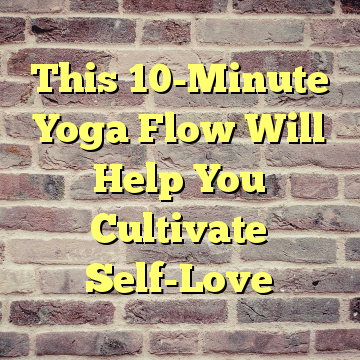
This 10-Minute Yoga Flow Will Help You Cultivate Self-Love
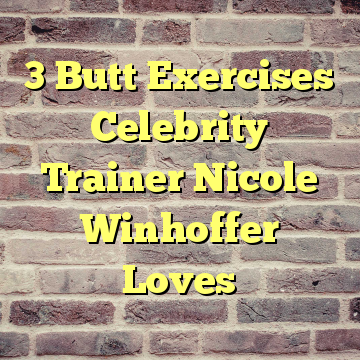
3 Butt Exercises Celebrity Trainer Nicole Winhoffer Loves
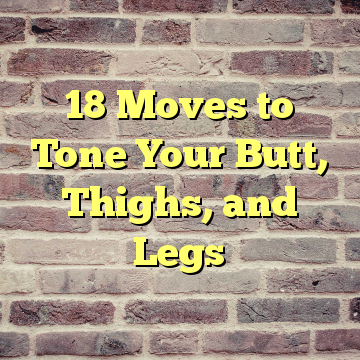
18 Moves to Tone Your Butt, Thighs, and Legs
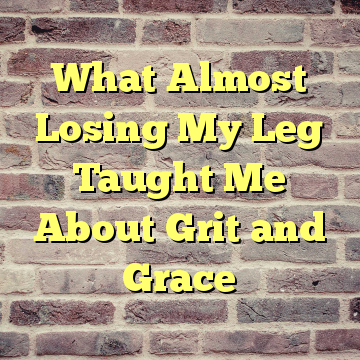
What Almost Losing My Leg Taught Me About Grit and Grace
Still riding the high that came with nailing a pre-marathon tempo run just an hour earlier, I was completely thrown by a sudden onset fever, torrential sweating, nausea, and searing pain in my left ankle. Considering I was attending back-to-school night for my two teenage daughters, Adair and Taylor, when the symptoms hit, not embarrassing them by vomiting or fainting in one of their classrooms was my primary concern. And, once I was home—and after a full-on internet searching session—I decided it was “simply” a stress fracture.
When I finally visited an orthopedic surgeon friend a couple days later, he was justifiably irritated with my flippant diagnosis and delayed treatment, but also confused. An X-ray and MRI showed no injuries, so he took fluid from my engorged ankle and cultured it over the weekend.
It was Labor Day weekend 2016, meaning I had plenty of time to writhe in pain—I birthed two babies and this was worse—and be frustrated that I didn’t have the energy to crew for friends in The Grand Traverse, an ultra trail race from Crested Butte to Aspen, Colorado. I was actually supposed to be running with them. Nothing made sense.
Tuesday morning dawned with a text from my doctor saying, “You need to come in today.” Denial was at an all-time high, so I tried to delay the visit using deadlines, my husband being out of town, and my kids as excuses. Yet my doctor’s insistence was raising a red flag (as if the pain, need for crutches, and listlessness weren’t enough), so I drove myself the hour to his office and hobbled into an exam room around noon. Things got serious quickly: My diagnosis was a staph infection in the ankle joint, and it was spreading up my leg towards my knee.
At this point, the doctor was fairly certain he could save my leg (WTF!) if he went in and flushed out the infection, and so I began massive doses of antibiotics and was admitted to the hospital that day for observation.
Yet I balked. My husband wouldn’t be back until Thursday. The kids were home alone and I had the car. I didn’t like taking medicine. He cut through my feverish haze by explaining that if I postponed treatment until Thursday, I would definitely lose my leg. And waiting until Friday would be the final nail in my coffin, literally. So at 3 pm, I entered surgery.
RELATED: I Lost My Leg in the Boston Marathon Bombing—and Then Trained to Run the Race
When I awoke, I immediately looked toward my foot. It was still there! But little did I know, surviving treatment and surgery was the easy part. Living again would be the real test.
Still not grasping the severity of my condition, I asked the good (I’m still here after all) but decidedly humorless infectious disease specialist how all the meds I was taking would affect my training for the New York City Marathon. I felt myself shrinking into the bed and falling into a black hole of hopelessness as she explained not only should I never expect to run or race again, it was time to find a new hobby.
As the infection began to subside, instead of relief, a smoldering anger took hold of me. Many people emerge from such events with a newfound joy and gratitude for life. I on the other hand was pissed. I threw myself into physical therapy, yoga, Pilates, weight training, relearning how to walk and swimming. Movement was my medicine and soul balm, and I was all in for two, three, sometimes upwards of five hours a day.
Feeling inspired, I decided my therapy would be training for and completing a 70.3 half Ironman triathlon (1.2 mile swim, 56-mile bike ride, and 13.1 mile run). I started biking, and by January 2017 even began alternating jogging with walking. Minutes turned into miles, but it wasn’t the same. The infection left me with limited mobility in my ankle, resulting in a rather awkward stride that caused new niggles in my knees and hips.
RELATED: I Lost a Leg After My Helicopter Crashed in Afghanistan. Sports Helped Me Get My Life Back
After finishing the Bolder Boulder 10K that May, my body began to rebel. Besides the aches, pains, and permanently creaky ankle, my endurance was now nonexistent. All the years of running and racing no longer mattered, and, as far as my body was concerned, “we” were starting over. I suffered repeated bouts of bronchitis by taxing my asthmatic lungs harder than they were ready to be pushed, caught colds on the regular and had a stomach ulcer kick in for good measure. Sleep was what I needed, yet I was still ‘sleeping’ with the light on from PTSD due to the entire experience.
By finding moderation and doing my best to let go of expectations, I was able to finish Ironman 70.3 Boulder 11 months after being told I would never run again. And my anger was finally replaced with wave after wave of tearful relief and appreciation as I collapsed into Adair’s arms at the finish line.
But my story doesn’t end with a finisher’s medal and a smile. Before I got sick, I was certain my fastest marathon was yet to come. Now, whether or not I’ll ever run another is uncertain, and, for the first time in years, I have no running-related goals.
Anger only got me so far, and it was exhausting. Grace is my new goal: grace in accepting where I am, in being kind to myself, in finding humor in the limp that comes when I’ve done “too much,” in deciding what’s next, and being joyful for the accomplishments of my more able-bodied friends. It’s hard, harder than any finish line I’ve crossed, because wanting more is my natural inclination. The ultimate lesson, I suppose, comes in wanting what you have. And as I look down at my two feet, I have 9.5 gnarly toenails from running thousands of miles, and I’m grateful.
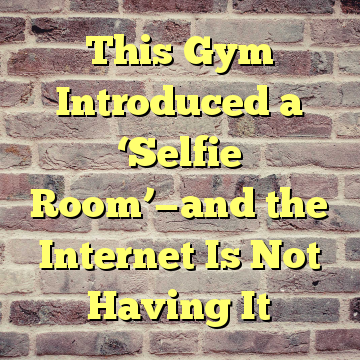
This Gym Introduced a ‘Selfie Room’—and the Internet Is Not Having It
While scrolling through the social media accounts for The Edge Fitness Club, a gym franchise in Connecticut, one thing is very clear: their members love a good sweaty, workout selfie. You’d be hard-pressed to find an image in the gym’s IG feed that does not depict someone weight lifting or showcasing their post-workout abs for the camera. Basically, it’s the ultimate fit-spiration.
While some people would die of embarrassment from flexing their newly-defined triceps in a selfie, there are many others who don’t think twice about snapping pictures of their booty in front of a mirror at the gym. Plenty of people want to document —with clear, visual evidence—their fitness progress, and who are we to judge?
After noticing that many of their members love a good gym selfie, The Edge recently commissioned an online survey conducted by The Harris Poll of 1,500 adults to learn more about the trend. The result? A whopping 43% of the respondents said they had taken photos or videos of themselves at the gym, and 27% of those photos were in selfie mode. Armed with these numbers, the gym decided to pioneer its way to offering the first ever “selfie room” at their Fairfield, CT, location. Members were told they would soon be granted access to the photo room, which would be equipped with good lighting, hair products, and fitness accessories to help them optimize their gym selfie to the absolute fullest. (And no, it wasn’t an April Fool’s joke, apparently.)
But gym-goers quickly took to social media to clue The Edge in on how they really felt about the so-called selfie room, and it was not pretty. At all.
Not everyone was against the idea, though.
Regardless, the backlash was enough to make the gym rethink their plan. “As of now, we are unsure if The Edge will be putting this on hold indefinitely or if it will come to fruition,” a PR representative for the company told Health in an email. “The Edge is taking into account the feedback they received from our members and are evaluating from there.”
So, April Fool’s after all?